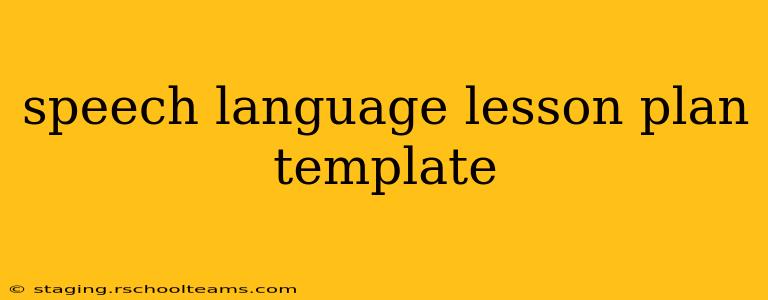This template provides a framework for creating effective and engaging speech-language therapy lesson plans. It's designed to be adaptable for various age groups and skill levels, focusing on clear objectives, targeted activities, and assessment strategies. Remember to always tailor the plan to the individual needs of your client.
I. Student Information:
- Name:
- Date of Birth:
- Diagnosis:
- Goals (Long-Term & Short-Term): List both long-term goals (overall improvement areas) and short-term, measurable goals that contribute to the long-term goals. Example: Long-term goal - Improve articulation of /s/ and /z/ sounds. Short-term goal - Correctly produce /s/ and /z/ in 80% of trials during single-word production.
- Session Duration: (e.g., 30 minutes, 45 minutes)
II. Lesson Objectives: (SMART Goals – Specific, Measurable, Achievable, Relevant, Time-bound)
- State the specific skills the student will learn or improve during this session. These objectives should directly relate to the short-term goals. Example: The student will correctly produce the /s/ sound in isolation with 90% accuracy.
III. Materials:
- List all necessary materials, including visual aids, manipulatives, technology, etc. Be specific! Example: Picture cards of words with /s/ and /z/ sounds, mirror, speech bubbles, colored pencils.
IV. Procedure:
(This section outlines the step-by-step activities of the session. Be detailed and specific.)
- Warm-up (5-10 minutes):
- Describe the warm-up activity. This could involve a simple game, review of previous material, or a fun activity to engage the student. Example: Play a quick game of "I Spy" focusing on words beginning with /s/ and /z/.
- Activity 1 (10-15 minutes):
- Target: (Specific speech sound, language skill, etc.) Example: /s/ sound production in isolation.
- Activity Description: (Detailed description of the activity and how it targets the objective) Example: The student will produce the /s/ sound in isolation while looking in a mirror to observe mouth placement. We will use visual and auditory cues to support accurate production.
- Data Collection: (How will you measure progress during the activity?) Example: Record the number of correct and incorrect productions.
- Activity 2 (10-15 minutes):
- Target: (Specific speech sound, language skill, etc.) Example: /s/ sound production in words.
- Activity Description: (Detailed description of the activity and how it targets the objective) Example: The student will produce the /s/ sound in words presented on picture cards. We will utilize a carrier phrase ("I see a...") to support production.
- Data Collection: (How will you measure progress during the activity?) Example: Record the percentage of correct productions.
- Activity 3 (Optional, 5-10 minutes):
- Target: (Specific speech sound, language skill, etc.) Example: /s/ sound production in sentences.
- Activity Description: (Detailed description of the activity and how it targets the objective) Example: The student will produce the /s/ sound in pre-made sentences. The sentences will increase in complexity.
- Data Collection: (How will you measure progress during the activity?) Example: Record the percentage of correct productions.
- Cool-down (5 minutes):
- Describe a brief activity to end the session. Example: Review the session's achievements and preview the next session's focus.
V. Assessment:
- Data Analysis: How will you analyze the data collected during the activities? Example: Calculate the percentage of correct responses for each activity.
- Observations: Record any observations about the student's performance, engagement, and challenges encountered.
- Modifications: Note any modifications made to the lesson plan based on the student's performance.
VI. Homework/Carryover Activities:
- Suggest activities the student can perform at home to reinforce the skills learned in the session. Example: Practice saying words with /s/ and /z/ sounds with a family member.
VII. Reflection:
- What went well?
- What could be improved?
- What modifications need to be made for the next session?
This template is a starting point. You may need to adjust it based on the specific needs of your client and the therapy setting. Remember to always prioritize the student's individual needs and learning styles when developing your lesson plans. Documenting this information meticulously is crucial for tracking progress and demonstrating the effectiveness of your interventions.
